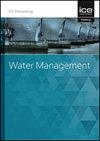Roller fluctuations of pre-aerated high-Froude-number hydraulic jumps
IF 1.1
4区 工程技术
Q3 ENGINEERING, CIVIL
Proceedings of the Institution of Civil Engineers-Water Management
Pub Date : 2023-01-31
DOI:10.1680/jwama.21.00046
引用次数: 2
Abstract
This work presents an experimental study of the fluctuating properties of hydraulic jump rollers for high-Froude-number and pre-aerated inflow conditions, to investigate the validity of empirical relationships in the literature that are derived typically from experiments for smaller Froude numbers and clear-water approach flows. The jump roller fluctuations are evaluated in terms of the dimensions of the roller surface profile, the fluctuation magnitudes and frequencies of the instantaneous jump toe positions and water elevations including at the tailwater surface, and the formation frequency and advection velocity of internal vortices in the shear layer. The effects of pre-aeration are found primarily in the length-scale properties such as jump length and surface fluctuation magnitudes, while the time-scale properties such as characteristic frequencies of the unsteady motions are not affected. Extrapolation of existing quantitative prediction of jump roller dynamic properties to high-Froude-number flow conditions should be performed carefully. An assessment of the fluctuating bubble counts within fixed time intervals yields close frequencies between the bubble grouping motions in the shear layer and the jump toe and tailwater wave motions, thus implying possible correlations between the roller surface deformations and air entrainment.预曝气高弗劳德数液压跳跃的滚筒波动
这项工作提出了高弗劳德数和预充气入流条件下液压跳跃辊波动特性的实验研究,以调查文献中经验关系的有效性,这些关系通常来自较小弗劳德数和清水接近流的实验。根据滚轮表面轮廓的尺寸、瞬时跳趾位置和水高度(包括尾水表面)的波动幅度和频率以及剪切层内涡的形成频率和平流速度来评估跳轮波动。预曝气的影响主要体现在长度尺度上,如跳跃长度和表面波动幅度,而时间尺度上,如非定常运动的特征频率,则不受影响。现有的跳跃辊动力特性定量预测应谨慎外推高弗劳德数流动条件。对固定时间间隔内波动的气泡计数的评估得出剪切层中的气泡组运动与跳趾和尾水波运动之间的频率接近,从而暗示滚轮表面变形与空气夹带之间可能存在关联。
本文章由计算机程序翻译,如有差异,请以英文原文为准。
求助全文
约1分钟内获得全文
求助全文
来源期刊
CiteScore
2.10
自引率
0.00%
发文量
28
审稿时长
6-12 weeks
期刊介绍:
Water Management publishes papers on all aspects of water treatment, water supply, river, wetland and catchment management, inland waterways and urban regeneration.
Topics covered: applied fluid dynamics and water (including supply, treatment and sewerage) and river engineering; together with the increasingly important fields of wetland and catchment management, groundwater and contaminated land, waterfront development and urban regeneration. The scope also covers hydroinformatics tools, risk and uncertainty methods, as well as environmental, social and economic issues relating to sustainable development.

 求助内容:
求助内容: 应助结果提醒方式:
应助结果提醒方式:


